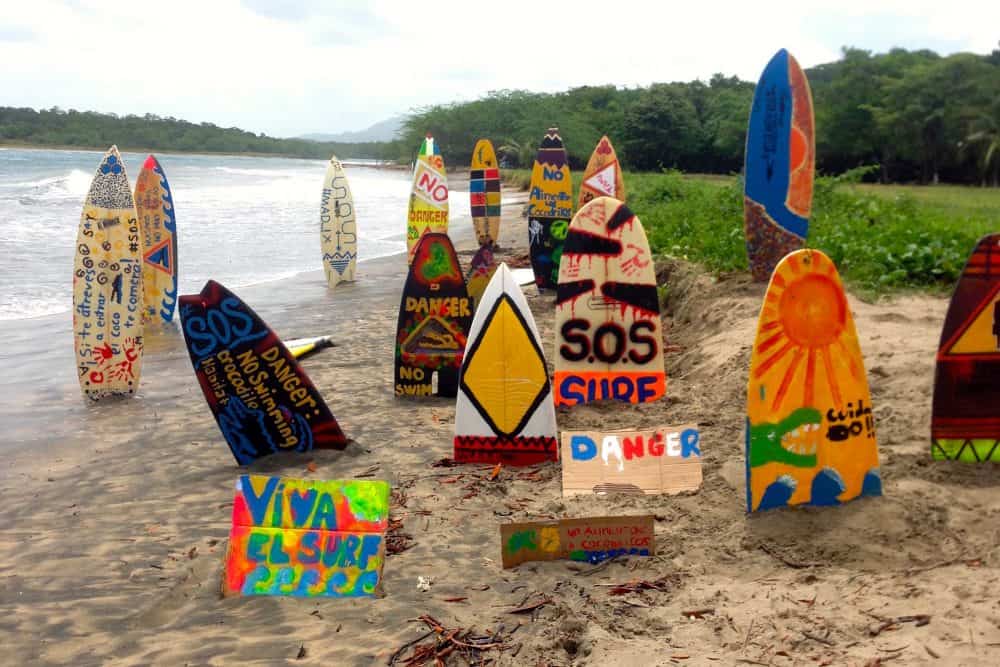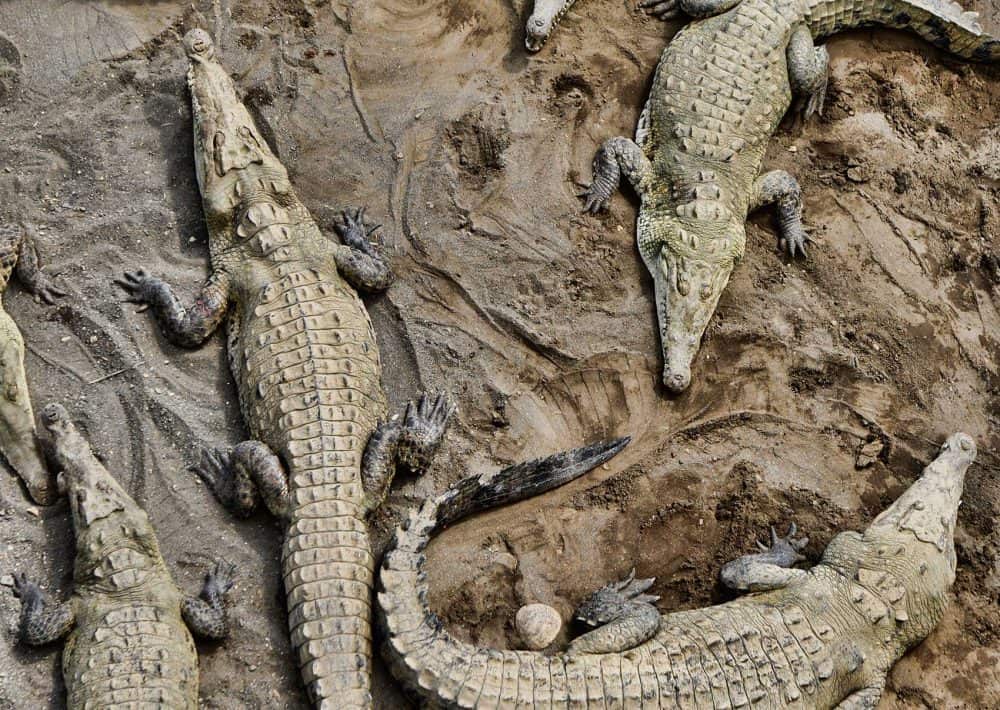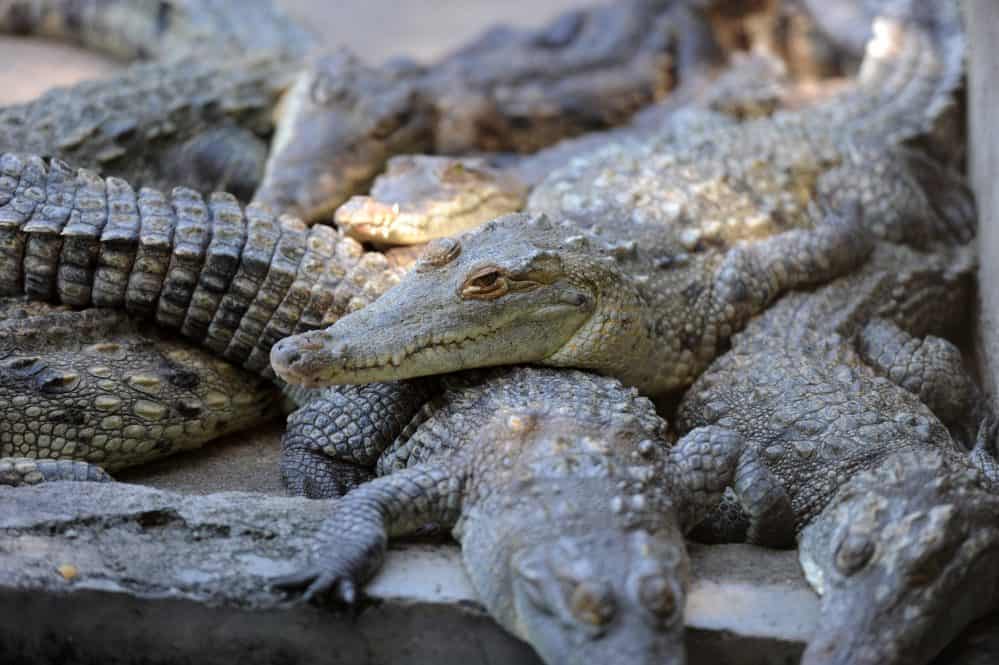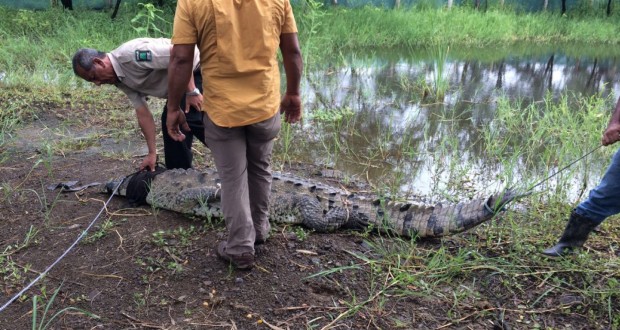A legal case before the courts may bite back at the population growth of crocodiles in Costa Rica – during a month when, thanks to heavy rains and the impact of Tropical Storm Nate in Costa Rica, concern about crocodiles spiked because of overflowing rivers.
Walter Brenes Soto, the lawyer who filed a lawsuit against the Costa Rican government over crocodile attacks and presence in populated areas, says he’s expecting a ruling sometime this month – and regardless of the court’s decision, his suit has inspired discussion and action in affected areas.
Brenes, who lives in Playa Hermosa, filed the suit against the Environment Ministry’s National System of Conservation Areas (SINAC), asking that the government begin studies to determine the number of crocodiles inhabiting waters in areas populated by humans. He says his ultimate goal is protect human life from these creatures while respecting the biodiversity of the country.
The suit, which was filed on June 30, was initiated by Brenes after crocodiles appeared in the surfing lineup of last year’s World Surf League Qualifying Series contest in Esterillos Este, on the Central Pacific coast. The crocodile sightings forced the athletes out of the water, and the competition was postponed for the safety of participants.

That event, coupled with the attack by a croc on U.S. surfer Jon Becker while paddling across the Tamarindo estuary that resulted in the amputation of his foot, led Brenes to investigate the laws governing the oversight of these animals here in Costa Rica to see what can be done to prevent future dangerous incidents.
“SINAC had no recent studies or statistics about the crocodiles,” explained Brenes. “We don’t know how many we have in the country. I wanted a lawsuit that addresses plans to regulate the growth of the number of crocodiles so we will know if they are a danger to fishermen, tourists, boat men, surfers, swimmers…The lawsuit forces the government to do this and clears the way for action, if necessary.”
The Costa Rican government has made commitments to regulations such as those included in the Convention on International Trade of Endangered Species of Wild Flora and Fauna (CITES), which protects wildlife species. As a result of CITES, that year, 1974, the government compiled a list of animals designated for extinction of which crocodiles are one. According to Brenes, however, that list has not been fully revised since then, and reports of recovering crocodile populations suggests that the animals’ danger of extinction may have lessened.

In order to update this list, the government must monitor and study the animals, and Brenes claims that’s just not being done. The Tico Times contacted local and national SINAC representatives but did not receive a response by press time.
In late September, a man working on the edge of a canal in Palma Sur de Osa was attacked by a crocodile and treated for five wounds on his face and head. In April, a young man was also attacked in the river mouth of the Tárcoles, a place where hundreds of these crocodiles congregate below the famous tourist overlook on the bridge to Jacó.

There are two sides of the issue. On one are those that say: Leave the animals alone. They were here first, and they just doing what they do naturally.
But the voices of those who see the abundance of crocs as a problem are getting louder. Andrea Díaz, founder of the community group Surf 4 Youth and a surf instructor who has lived in Hermosa de Jacó, Tamarindo and now Nosara, makes her livelihood in the ocean. She was very active in the Tamarindo meetings about the situation there after Becker’s attack, and she is happy about Brenes’ lawsuit.
“Finally! Someone is doing something about it,” she told The Tico Times. “We can’t just keep turning our head away and ignore this any longer. I’m afraid they are going to eat me or one of my clients. Nowadays, if I mention that I used to be from Tamarindo, the first thing that comes to their mind is crocodiles.”
On his own, Brenes contacted a group of experts to back up his claims. These include Juan Rafael Bolaños Montero, the founder of the Crocodile Specialists Association in Central Americaand member of a group of crocodile specialists from the International Union for the Conservation of Nature (IUCN); Iván Sandoval Hernández, a professor and researcher from the Biological Sciences School at the National University (UNA); and Fabian Bonilla Murillo, a biological tropical herpetology specialist and biology regent at the Clodomiro Picado Institute at the University of Costa Rica (UCR). These men evaluated SINAC’s actions in the years 2011-2012, and studied the controls that were supposed to be in place. They found them wanting, Brenes indicates.
The lawyer says he believes the next step, as a result of a favorable ruling from the court, which he hopes he will receive early this month, would be for SINAC to begin studies of the crocodiles population in the most congested areas. At the very least, he’d like to see monitoring in Parrita, Río Tempisque, Playa Jacó, Playa Esterillos, Rió Tárcoles, Tamarindo and nearby beaches.

Jason Torres, a national surf champion who lives in Jacó, reported: “I see a lot of crocs over there in Hermosa and Jacó, but I don’t know if they are no longer scared to be around humans. It’s more like a fact of being lucky and if you are in the wrong spot or a mom is protecting her young when you are in the water, then you are in trouble.”
Tamarindo is an example of how when the government takes action, changes can be made. Brenes filed a different lawsuit on behalf of that community last year in order to find a solution to the dangerous crocodile that attacked Becker a few months earlier and was reportedly coming into public areas. For weeks after the attack in July, with the urging of local organizations such as the MINAE, the National Police, the Guanacaste Tourism Chamber (CATURGUA), the Development Association (ADI) of Tamarindo, and members of the community, SINAC officials and crocodile experts studied the animals in the Tamarindo river mouth.
The group concluded that local fisherman were feeding the crocs, desensitizing them to humans and causing them to venture into areas normally reserved for surfers and swimmers. One of the larger crocodiles was identified as the culprit, and on Oct. 16, 2016, administrators of Las Baulas National Marine Park, along with scientists and volunteers, captured the croc and relocated it to Rancho Humo.

Relocation may not be the answer for every spot where crocodiles are a threat to human life. One problem, Brenes mentioned, was the lack of appropriate places to relocate crocs that have been classified as dangerous. As a result, he is meeting with various groups to see what other options may exist. These groups include the National Tourism Chamber of Costa Rica (CANATUR) and the UCR’s Clodomiro Picado Institute, and the National University’s School of Biology.
Another issue that may come up, should the system rule in favor of Brenes’ suit, is how the government will fund the population studies.
“If I win, the government will be obligated to do something,” Brenes said. “First, they have to do a study, then move the crocodiles that are dangerous to humans. I don’t know if we have overpopulation, but if we continue this way doing things like feeding crocs and building houses in the affected areas, things will be more dangerous than they are now. We don’t have the same conditions now that we had 10 years ago.”
Still, he’s optimistic overall: “It’s looking good for us.”
See also: Why one Costa Rican lawyer is suing the government over crocodiles






